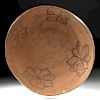Rare 18th C. Zuni Pottery Bowl - Floral Motif
Lot 58e
About Seller
Artemis Fine Arts
686 S Taylor Ave, Ste 106
Louisville, CO 80027
United States
Selling antiquities, ancient and ethnographic art online since 1993, Artemis Gallery specializes in Classical Antiquities (Egyptian, Greek, Roman, Near Eastern), Asian, Pre-Columbian, African / Tribal / Oceanographic art. Our extensive inventory includes pottery, stone, metal, wood, glass and textil...Read more
Estimate:
$6,000 - $9,000
Absentee vs Live bid
Two ways to bid:
- Leave a max absentee bid and the platform will bid on your behalf up to your maximum bid during the live auction.
- Bid live during the auction and your bids will be submitted real-time to the auctioneer.
Bid Increments
| Price | Bid Increment |
|---|---|
| $0 | $25 |
| $300 | $50 |
| $1,000 | $100 |
| $2,000 | $250 |
| $5,000 | $500 |
| $10,000 | $1,000 |
| $20,000 | $2,500 |
| $50,000 | $5,000 |
| $100,000 | $10,000 |
| $200,000 | $20,000 |
About Auction
By Artemis Fine Arts
Oct 3, 2019
Set Reminder
2019-10-03 10:00:00
2019-10-03 10:00:00
America/New_York
Bidsquare
Bidsquare : Exceptional Day 2: Pre-Columbian & Tribal Art
https://www.bidsquare.com/auctions/artemis-gallery/exceptional-day-2-pre-columbian-tribal-art-4453
Day 2 of an important 2-day auction featuring exceptional, museum-worthy examples of Pre-Columbian from the ancient Americas, Native American, African / Tribal, Oceanic, Spanish Colonial and fossils. Artemis Fine Arts info@artemisfinearts.com
Day 2 of an important 2-day auction featuring exceptional, museum-worthy examples of Pre-Columbian from the ancient Americas, Native American, African / Tribal, Oceanic, Spanish Colonial and fossils. Artemis Fine Arts info@artemisfinearts.com
- Lot Description
Native American, Southwest, Zuni, ca. late 17th to early 18th century CE. Impressive for so many reasons - its age (dating to the period of the Pueblo Revolt of 1680 to early 1700's!), beautiful floral motifs, and grand scale - this gorgeous piece of Zuni pottery was handbuilt in the traditional coil-and-scrape manner, coated with an orange slip and hand-painted with black decorative motifs. The overall form is simple yet elegant, presenting a broad deep form with flared walls that curve inwards just beneath the rim. However, the decoration is intriguing. The artist painted three 8-petaled flowers with stamen and a two dotted petals each as well as one crossed, dotted square (the dots perhaps indicative of frog eggs) - all set equidistantly on the interior walls. Zuni Pueblo artists are known for their beautiful painted pottery with designs that have traditiionally been symbols for botanical specimens, water, frogs, and tadpoles. Size: 15" in diameter x 6.75" H (38.1 cm x 17.1 cm)
A piece like this was handbuilt in the traditional way, using clays dug from the Zuni Pueblo, hand-kneading it with old sherds used as temper, hand-built from coils, scraped and smoothed. Then mineral slips and paints were applied, and the vessel was fired in an open fire. Most early Zuni pottery was utilitarian, but when decorated like this example, the pieces most likely had an intended meaning, adorned with symbols that had been passed down from generation to generation. Zuni potters in particular demonstrated an incredible continuity in their design programs - some 7,000 years - and actually helped the Hopi revive their tradition.
Provenance: ex-private E. Thomas collection, San Diego, California, USA
All items legal to buy/sell under U.S. Statute covering cultural patrimony Code 2600, CHAPTER 14, and are guaranteed to be as described or your money back.
A Certificate of Authenticity will accompany all winning bids.
We ship worldwide and handle all shipping in-house for your convenience.
#150179A couple of stable pressure fissures from the rim (about 1" long). Slip shows nice craquelure. Painted decorations have faded a bit but still retain strong forms. Covered with mineral deposits.Condition
- Shipping Info
-
All shipping is handled in-house for your convenience. Your invoice from Artemis Gallery will include shipping calculation instructions. If in doubt, please inquire BEFORE bidding for estimated shipping costs for individual items.
-
- Buyer's Premium



 EUR
EUR CAD
CAD AUD
AUD GBP
GBP MXN
MXN HKD
HKD CNY
CNY MYR
MYR SEK
SEK SGD
SGD CHF
CHF THB
THB












